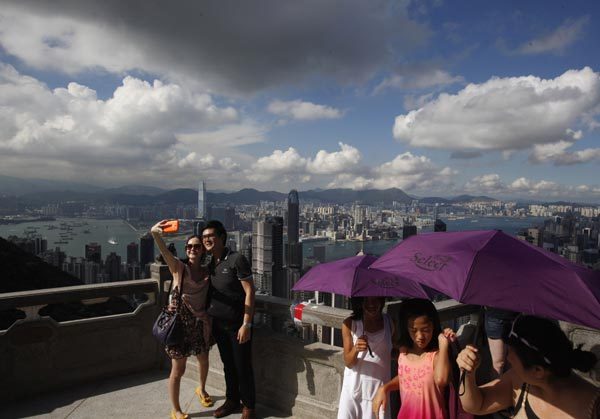|
 |
|
Mainland tourists at the Peak overlooking Hong Kong. Retailers in the city are feeling the pinch as the number of mainland visitors to the city continues to drop. [Photo/China Daily] |
Although relying on the spending power of mainland tourists, Hong Kong has been experiencing a number of cross-border incidents, Emma Dai reports
It was 7:30 on a Sunday night-a time when visitors usually end a day of shopping by exiting the malls and entering restaurants. Yet Causeway Bay, the holy grail of shoppers in Hong Kong, was not as busy as usual-there were shorter queues for fitting rooms, less people under the mega-screens of Russell Street, and even the notorious sidewalk traffic wasn't as bad on the corner in front of Japanese department store SOGO. But while shopping was more pleasant, on the side streets, shops-large and small-h(huán)ave been quietly shutting down. Further testament to trouble in the retail district were the layers of for-lease ads pasted on the rolling doors.
According to the Census and Statistics Department, the value of total retail sales decreased 9.8 percent year-on-year in April to HK$38.8 billion ($5 billion), a much steeper drop than the predicted 4.4 percent decline. Retail sales volume also tumbled 9.5 percent in the same period last year.
It is the third consecutive month that the city had recorded retrenchment in the retail sector-after sales dropped by 1.3 percent year-on-year in March and 2.2 percent in February. It was the worst slump since May 2003, when severe acute respiratory syndrome, or SARS, crippled the city.
Luxury stores have suffered the most. Sales of Swiss watches, Italian handbags and French jewelry dived 39.9 percent year-on-year in April. Separately, sales of mobile phones, tablets and cameras-h(huán)ot gadgets among mainland tourists-also tumbled 8.3 percent. Even normally busy department stores recorded a 1.3 percent decline during the month.
While blaming last year's gold rush as a high comparison base, Barclays Bank Plc added in a June note that the dwindling number of mainland tourist arrivals has played its part. According to Hong Kong Tourism Board, the number of mainland visitors rose 14.7 percent year-on-year in April-still rising, but at a "much slower" pace compared with the 27 percent rise in March and 20 percent for the first quarter.
Earlier data from Goldman Sachs Group Inc estimated that mainland visitors contributed HK$217 billion, or 37 percent, to overall retail sales in Hong Kong last year.
But today, they are buying less than three years ago, Barclays wrote in another report published on May 30. The wealthy are decamping to far-off locales like Europe and the United States. Even Japan is luring the budget-conscious as an attractive destination with the yen depreciating.
Hong Kong retailers are on a cliff, cautioned Caroline Mak, chairman of the Hong Kong Retail Management Association.
"Last month, customer traffic started to decline," Mak told Hong Kong media. "Some shops targeting mainland visitors have had to offer an average discount of 20 percent or even 30 percent. Many suffered a 10 to 15 percent decline in same-store sales. This is not a sustainable way to do business, especially as costs remain sky-high."
|
 |
 |
| Top 10 world's biggest retailers | Top 10 favorite luxury brands of Chinese women |
